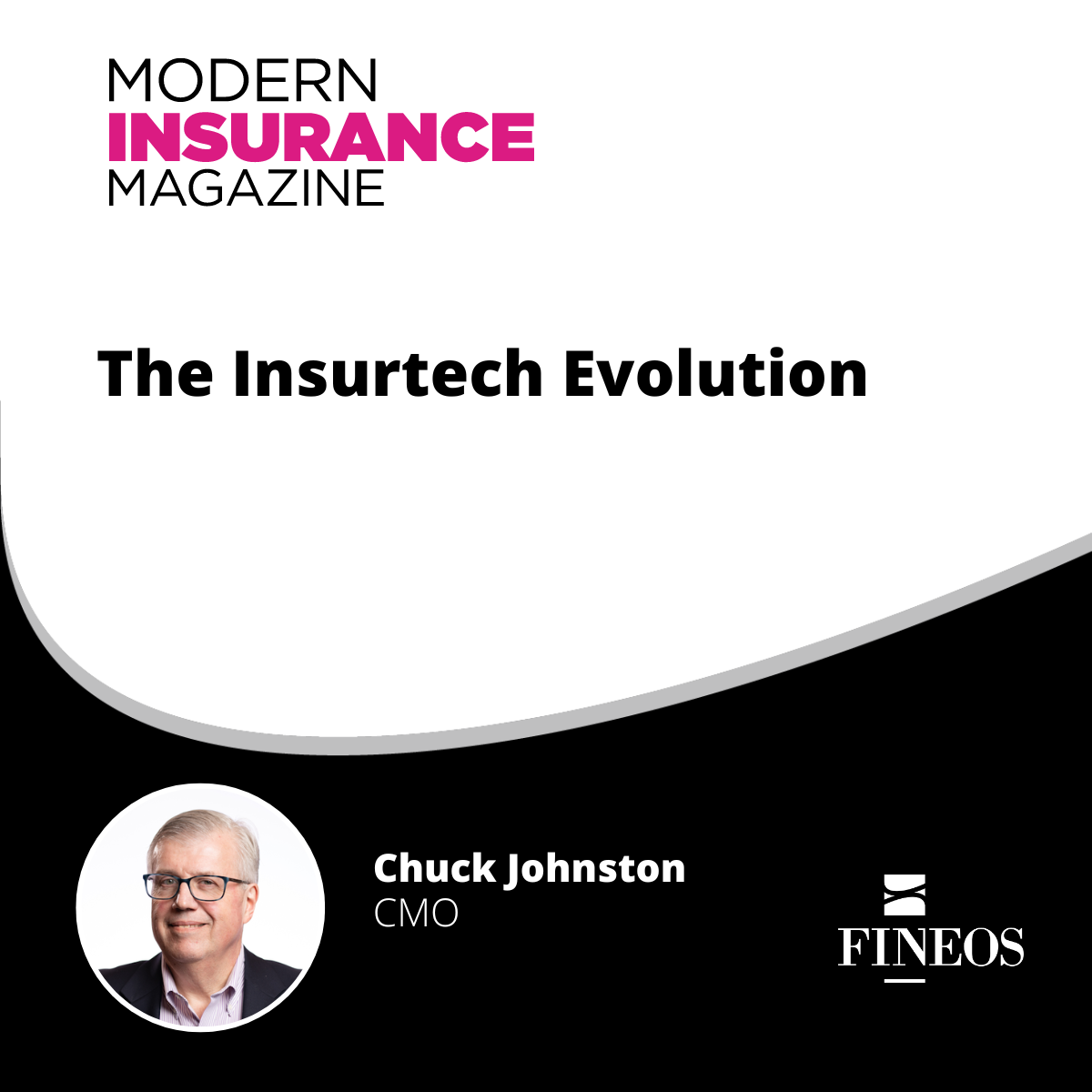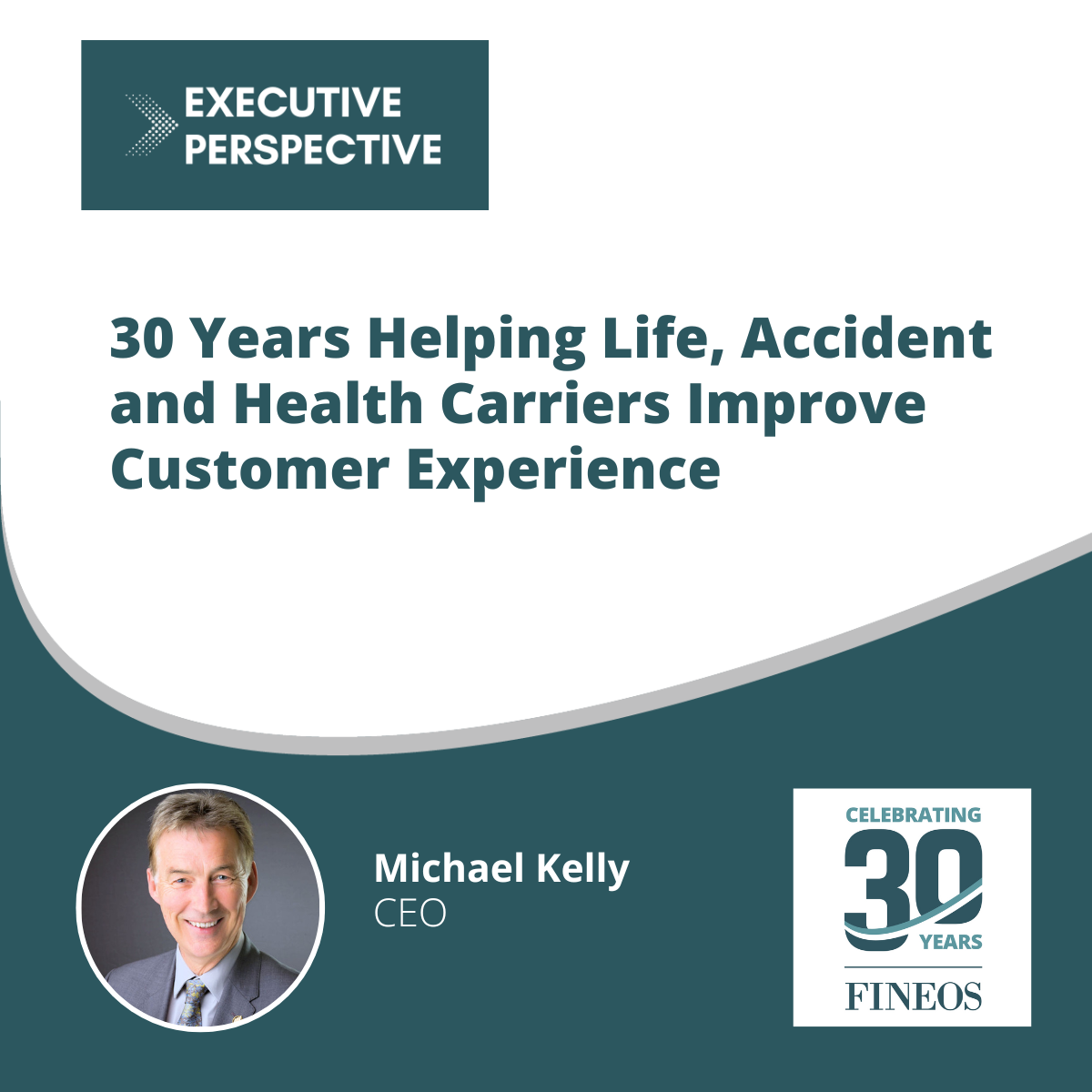Original article appeared in Insurance Innovation Reporter August 2022
IIR talks with FINEOS CEO Michael Kelly about the company’s positioning since its IPO in 2019, and its transformational engagement with New York Life Group Benefit Solutions.
At its founding in 1993 in Ireland, FINEOS (Dublin) bet that the long-term viability of the life insurance industry would be built on delivering excellent customer care and service using modern core insurance technology. The company gained important clients early on—including Britannia Life, Allianz Life and ABN AMRO Life —and developed a customer-centric component-based policy administration core product suite for the unit-linked, universal life insurance market in Europe. It has weathered major economic downturns and managed to go from strength to strength without outside investment, and through judicious technology and business decisions.
FINEOS began to focus on claims management in the early 2000s, eventually establishing a leadership position in life, accident and disability claims management software in several global markets. The company shifted from a claims focus to building a complete, cloud-based platform for group insurance. The company made its IPO in 2019, with a view to raising cash for further development and expansion. IIR recently spoke to FINEOS CEO Michael Kelly about the vendor’s current position, and the importance of its several-year engagement with New York Life Group Benefit Solution to the evolution of its industry offering.
Insurance Innovation Reporter: How would you describe where FINEOS is today in terms of its overall evolution and its strategic direction? Maybe a good jumping off point would be your IPO in 2019.
Michael Kelly, CEO, FINEOS: Our IPO was part of a seven-year strategy whereby we moved from disability claims management and life claims management—on an on-premise system—to a complete platform for the group insurance industry. On that journey, we could see from a very early stage that our direction would be group and voluntary benefits. We then also worked in absence management as part of this employee benefits platform. That evolution was well underway when we did our IPO in 2019.
We had sold our platform to three very large carriers in that year, and we needed to power the product development even further to support the highest quality of implementations for the new platform from 2019 onwards. So, one of the reasons we did the IPO was to raise cash—to further invest in product, to help us to get our implementations of the platform correct, and to round out the full core platform. We added on digital and data-type facilities using machine learning and AI. We also improved the data analytics and automation capabilities that we saw as necessary to a true platform for a big industry such as employee benefits.
IIR: Having arrived at this point in the company’s evolution, what are some of most important strategic objectives for FINEOS today?
MK: Today we’re interested in moving carriers in the employee benefit space away from their legacy systems and onto the FINEOS Platform. That also implies some change in terms of their legacy business processes and the approaches that they’ve taken historically. However, it will also inject greater flexibility and operational efficiency into their organizations. In turn, that will create a better customer experience, because many of these carriers are prisoners of their legacy environment. Many of their processes are very much in place because of the legacy situation that they’re in. You might see a lot of broken processes, processes that don’t make sense, double entry in terms of data—or even triple entry in some cases. There are many validations that they have to do between systems and other inefficiencies, like double checks and audit processes, which in FINEOS is simply not required.
IIR: How would you contrast the FINEOS Platform with the legacy status quo at many companies?
MK: Our system is one true source, giving you a complete picture of the employer and the employee relationships, the products they have, the processes in place, and it’s joined up from end to end. So, we’ve just got one app core where everything that the carrier is doing for an employer and employee is kept in one place, where it can be automated or moved along in any way that makes the journey more pleasant for the employer or the employee. I think the big challenge for the industry is to get business people and IT people to let go of the past and to trust a purpose-built system like ours, which is now proven—it supports $4 billion in premium and 9 million customers—and we’ve replaced six legacy systems with it.
IIR: What are the technology implications of “letting go of the past”? How is that best done, and involving what major technology trends?
MK: Looking back 10 to 15 years, carriers differentiated themselves by the amount of IT investment and the differentiation of their IT systems. They thought that being unique and having IT systems to match was a massive competitive differentiator. Shift onto today’s world and the core systems of that era are now big maintenance problems. Those green screens, those poorly maintained systems, the loss of the IT folks who built them—all of that has become a huge burden on these carriers.
As a result, there’s been a shift in thinking at the executive level to say, “Why are we different than X, Y, Z carrier down the street that has exactly the same products and similar processes. Why shouldn’t we standardize?” So, the insurance world has gone from individualized to standardized systems in our world. Group insurance is a late-developing industry compared with P&C or some of the individual lines of business. Group insurance didn’t have a truly purpose-built group admin system for both group and voluntary benefits—with the absence management piece—until we developed and proved it.
IIR: How important is the cloud to executing on this shift in thinking?
MK: There are a number of advantages to moving to the cloud, and one is that cyber security and cyber protection is actually strongest in the cloud and those modern systems, they are built to withstand cyber-attacks, whereas legacy systems are open to attack and of course the other major reasons include the huge economies of scale and the instantaneous accessibility of computing power and the flexibility that comes with that. When you stand on top of that platform, systems—which are software-as-a-service—you’ve created a completely new dynamic. The software is maintained and managed by the vendor not by the carrier, and that saves the carrier a ton of money, time, energy, and focus.
IIR: Do insurers underestimate or overestimate the task of getting to the cloud?
MK: Some insurers probably underestimate the task, depending on what systems they’re moving to the cloud. However, we don’t ask them to move their systems to the cloud—just to convert. We’re inviting them to move their business to the FINEOS Platform, which is in the cloud already and is already built. We’re not asking them to build software or—as other vendors do—ask them to “lift and shift,” meaning effectively to take this software and plant it onto the cloud. We built this platform cloud-native in the cloud from day one, on AWS.
IIR: What are the greatest challenges for the group and voluntary benefits industry today, as that bears on the FINEOS strategy.
MK: We’re seeing great changes in employment in the states where it was historically a very regimented, rigid environment where people worked nine to five. They kept their jobs for a long time, they stayed in the same type of employers, and they had one-size-fits-all benefits. We see that employees are now looking for much more flexibility, and the war for talent is making employers sit up and listen to those demands. Employers are looking to retain their staff, and they’re looking for a benefits carrier with a more flexible benefits package that meets the needs of their employees.
The dynamic of the environment changed over the past five or six years, whereby employers are offering group and voluntary together. So, the employees can voluntarily pick up extra covers. There’s the whole area of absence management, which has made its way into the environment where the employer is listening and giving time off work for whatever it takes to keep the employee happy. Indeed the states are regulating this now. Now, various states are bringing in regulation that effectively legislates for that, and that could become federal law down the track.
IIR: How has FINEOS adapted to this changing environment, with regard to absence management?
MK: FINEOS is the absence management leader, with five of the top 10 group carriers in the U.S. using FINEOS for absence management. Seven of the top 10 group carriers are using FINEOS for claims and claims and absence. We effectively lead the market in this space with some of the biggest carriers already using our absence management system in production. Absence is really moving up the value chain of the claims side. We adjudicate whether an absence is a paid or a nonpaid absence, if it’s a claim for various injuries, illness, or whatever, and we can take that person on the journey to a return to work, return to health and so on — what we’ve added to the whole billing and the policy side.
Absence management is holistically supported within the whole platform, rather than being something that sits on the side as in the case of other vendors. It’s actually built in and interwoven within the whole system, and that’s what we envisaged when we began talking to New York Life Group Benefit Solutions. We began to picture what the employees’ world would be in seven years’ time from the outset. They had already implemented absence with group insurance and they said, “This is sitting out on the side. It needs to be woven in.” We replied that we fully agreed and were ready to build such a system.
IIR: What has the New York Life Group Benefit Solutions engagement meant to FINEOS’ evolution as a vendor?
MK: At New York Life Group Benefit Solutions, we were able to design and develop a standardized system, and from the outset, we decided that this would be an industry platform—not just another individualized system for a client. It had to be a standardized system and the business needed to change their processes to fit within it. So, we looked for the very best in terms of practices and processes.
IIR: When did the engagement begin, and what were some of its most important milestones?
MK: The project kicked off at the end of 2015. We spent a year doing an analysis of the industry and of what a standard platform would look like. We started to build out the product from 2016 onwards. The product initially went live in 2018 for just FMLA [the Family and Medical Leave Act] and New York state leave, and then policy and billing went live in 2019 and the full system was converted between 2019 and 2021. The full book of business was up-and-running by the end of 2021 and, New York Life eliminated six legacy systems in that process.
IIR: What are some of the major advantages New York Life has enjoyed as the result of the engagement?
MK: They no longer have the broken processes or various legacy systems that burdened them. What I would stress about what we’ve built with New York Life is that it’s unlike other offerings that many vendors have brought to the business, whether from the pensions or individual life world, or from P&C. They haven’t fully thought through the problem, and in many cases, carriers are paying them to do a great deal of software development, but for systems that are only patchwork in comparison to what we’ve stood up from day one—which was a purpose-built industry platform which today is proven with a $4 billion book. No one else has that and we’ve built it.
Because the system is proven with all their products, all the clients on it, and all that volume of data, we’ve been able to move to the next place, which is all about what you do with data: How do you intelligently use data? How do you analyze data? How do you use that data to predict the future? So, we’re working on things like predictive analytics, AI, and trying to make that data work on a very, very large portfolio of policies. We’re also working very hard on integration, and we were first to integrate the LIMRA (LDEx) standard into the FINEOS Platform. We have integrated into several third-party standard industry-type systems, and we’re continually building out the digital and the data side of the system whilst other vendors are, as I said, still trying to build software and make it work with the old legacy systems.
IIR: Where are you suggesting that other vendors have gone wrong in this vertical?
MK: A big mistake that vendors have made, I would call them the first generation of vendors in on the admin side—is that they’ve tried to make their systems work with the older legacy technology, and as a result, the carrier is now a prisoner of those half-baked systems with legacy and more vendor systems in pieces of the jigsaw puzzle. We lived in that world prior to what we did with New York Life Group Benefit Solutions, because in a prior world, we were a claims vendor who was stitching the claims system into the legacy world. We saw that journey ourselves. where we were asked to bend our claims system into working with whatever the carrier had—and we built a lot of customization around that to make that work. Now, today, we’re into standardization and shifting the carriers across to our platform—which is a mindset shift for the business and also IT. You get a far better result because you’re moving them away from the big prison of that old legacy environment.
By Anthony R. O’Donnell, Executive Editor of Insurance Innovation Reporter
Connect with Michael Kelly, CEO FINEOS
See more about the FINEOS and New York Life Group Benefit Solutions case study


